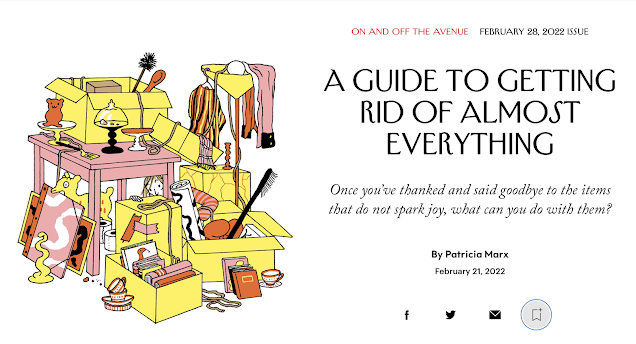Pearl reno: Susan's strand
Reader Susan sent this photo of her 3-4mm round white pearls (probably akoyas), a still-lustrous 18-inch strand, sentimental to her but too small as is for a grown woman. She asked if I had ideas for updating it, and wondered if they "were worth it". I'd say yes!
As I noted in this post on petite pearls, small pearls suit certain designs, and hers, given their condition and luster, beg for new life. (She could pull it apart to make a multi-strand bracelet or other project, but she requested a necklace.)
Let's look at two options.
Plan A: Pendant on pearls
Here, small pearls form the "chain" for a pendant. Below, an example of such a necklace with a pendant, the "Angel Pearl" necklace by Kate Hines; the silver-set freshwater baroque pendant is also available separately (price, $60):
If choosing a round pendant, I'd select a diameter of a nickel or not much bigger, for balance. She might have something she could re-purpose; if not, the world of pendants is vast! Some ideas at various price points:
For only $4.75, she could add this romantic French pendant from Etsy seller AllEarzJewelry:
The gold-plated snake, an Asian motif, adds substance and texture; this style attaches to the strand, rather than hanging off it. Should she have a few dull pearls on the strand, this would allow her to pick the best for the reno. (Price, $63). And see the centre loop of the snake? She could hang a pearl, gem or crystal bead from there.
A simple but luscious 12mm x 16mm flameball baroque peach pearl drop (price, $117) from Kojima Company is a soft, feminine addition that complements the luster of her whites:
A Victorian locket, set with an opal, would be a nostalgic choice. This one, 20mm, is 10k gold and made with intriguing detail. Price, $262 from Etsy seller Syboll Munger.
A vintage charm makes a witty pendant. This 14k diver is from BeladoraII (price, $495). You might already have a charm, but I like her retro vibe. I wouldn't go too sweet (heart, flower) or the necklace will look like you stole it from a 12-year-old. Also, the charm needs some size; Ms. Diver is a generous 1 1/2 inches.
Clasp
The dated filigree goes, right now! New clasp could be a small 24k vermeil fishook from Nina Designs about $17.
Susan could also troll rummage sales for broken pieces that include a clasp; I once found one for 50 cents. She'd look for the approximate size she has now, so it does not overwhelm the strand.
Attaching the pendant
The pendant attaches to the strand with a simple fixed ring (or rings) or delicate bail. (a bail is a hooplike attachment that is more substantial than a ring.) Some pendants have rings designed into them, and need a second small ring to hang correctly. (The Victorian locket shown has the two rings, all ready to go.)
Don't buy a bail before you choose the pendant, it may not fit. Bails are designed differently to accommodate top, side or front-drilled pendants. (See Nina Designs for many examples of bails.) Just like you'd choose the setting for a ring, choose the bail; it's literally front and center.
A snap or removable bail (sometimes called an "enhancer" style) would allow Susan to change pendants.
Plan B: Pinned pearls on chain
Susan could entirely transform her necklace to wire-wrapped dangles on chain. This is not a bead-store proposition. I'm showing an example by my pearl-design idol Zara Scoville of Priceless Imperfection, and it is she whom I recommend for the project.
The piece could use only Susan's pearls, but I'd suggest adding small keshis, for interest. Zara can choose pearls that harmonize; the wirework may be gold or silver.
In Plan B, the necklace is transformed, but the sentiment remains. The cost for such restyling is higher than for some pendants, but she has a completely new piece.
Does Susan need a jeweler?
For Plan A, Susan could buy her pendant and findings, take or send it to a bead store, and have it strung. This is the lowest-cost option if she has a clear sense of what she wants.
If unsure about design, a jeweler can help. In that case, she should bring along images of pieces she likes, or make sketches.
So many readers have asked, that I think talented jewelry designers must be in scarce supply. (Many "jewelers" today merely retail production pieces and do hardly any bench work. And a jeweler can do good technical work but lackluster design.)
I've recommended several who specialize in pearls, like Zara Scoville, Sarah Canizzaro of Kojima Company and Céline Bouré of Kokass; Etsy is another good place to check out talent. Given Skype, a design meeting is just a click away.
If you live in a place served by good jewelers (which is different from good jewelry stores), slip your inspiration folder into your bag and drop by. (Occasionally, jewelers can get huffy when they aren't supplying the pearls, others are fine with it.)
If there is no enthusiasm in the artist for undertaking the project, no matter how much you like his or her work, say thanks and leave. And vice-versa: an artist may be willing, but if his work on display is not your taste, the final product (no matter how versatile he claims to be) will not please.
Craft shows are another place to troll for artisans; if you like the work displayed, return during a quiet spell to discuss your project.
Costs
For Plan A, besides the cost of materials, Susan will pay for the stringing ($15-$60 depending on who does the work, and how complicated the necklace is) and a design fee if a jeweler gives significant input.
For Plan B, Susan will pay for additional pearls, if any, and for the making of the piece.
Susan could also just change the clasp and restring, then layer the necklace with others that she has, but that's not what she requested, and also, I wouldn't want those pearls abraded by chains or metal near them. The only thing that should touch a pearl is another pearl, or at least no metal, if you want to keep them in good nick.
Jewelers like to say you can step on a pearl; you can– it will not shatter unless there is an internal fault or it's one of the hollow 'soufflé' pearls- but the surface nacre will scratch, and metal is the meanie.
Susan's next steps
Susan has some decisions to make.
Should she try to spend as little as she can, or is it worth investing in something special? Would she be happy with a $5 Etsy pendant or is a pearl or gold charm worth saving for?
Does she want to keep the necklace as a strand, adding a pendant, or redesign it in an exciting new style?
Whatever her choice, she should aim for a necklace she doesn't want to take off. Pearls are meant to be worn; by spring, they could be out in the sunshine!
Do you have other ideas for Susan's necklace? We'd be eager to hear them!
 |
| Susan's little lovelies |
As I noted in this post on petite pearls, small pearls suit certain designs, and hers, given their condition and luster, beg for new life. (She could pull it apart to make a multi-strand bracelet or other project, but she requested a necklace.)
Let's look at two options.
Plan A: Pendant on pearls
Here, small pearls form the "chain" for a pendant. Below, an example of such a necklace with a pendant, the "Angel Pearl" necklace by Kate Hines; the silver-set freshwater baroque pendant is also available separately (price, $60):
If choosing a round pendant, I'd select a diameter of a nickel or not much bigger, for balance. She might have something she could re-purpose; if not, the world of pendants is vast! Some ideas at various price points:
For only $4.75, she could add this romantic French pendant from Etsy seller AllEarzJewelry:
 |
| AllEarz Jewelry @ Etsy |
The gold-plated snake, an Asian motif, adds substance and texture; this style attaches to the strand, rather than hanging off it. Should she have a few dull pearls on the strand, this would allow her to pick the best for the reno. (Price, $63). And see the centre loop of the snake? She could hang a pearl, gem or crystal bead from there.
 |
| Nina Designs pendant |
A simple but luscious 12mm x 16mm flameball baroque peach pearl drop (price, $117) from Kojima Company is a soft, feminine addition that complements the luster of her whites:
 |
| Kojima Company baroque pearl pendant |
A Victorian locket, set with an opal, would be a nostalgic choice. This one, 20mm, is 10k gold and made with intriguing detail. Price, $262 from Etsy seller Syboll Munger.
 |
| Syboll Munger Victorian gold locket |
A vintage charm makes a witty pendant. This 14k diver is from BeladoraII (price, $495). You might already have a charm, but I like her retro vibe. I wouldn't go too sweet (heart, flower) or the necklace will look like you stole it from a 12-year-old. Also, the charm needs some size; Ms. Diver is a generous 1 1/2 inches.
 |
| BeladoraII vintage 14k charm |
Clasp
The dated filigree goes, right now! New clasp could be a small 24k vermeil fishook from Nina Designs about $17.
Susan could also troll rummage sales for broken pieces that include a clasp; I once found one for 50 cents. She'd look for the approximate size she has now, so it does not overwhelm the strand.
Attaching the pendant
The pendant attaches to the strand with a simple fixed ring (or rings) or delicate bail. (a bail is a hooplike attachment that is more substantial than a ring.) Some pendants have rings designed into them, and need a second small ring to hang correctly. (The Victorian locket shown has the two rings, all ready to go.)
Don't buy a bail before you choose the pendant, it may not fit. Bails are designed differently to accommodate top, side or front-drilled pendants. (See Nina Designs for many examples of bails.) Just like you'd choose the setting for a ring, choose the bail; it's literally front and center.
A snap or removable bail (sometimes called an "enhancer" style) would allow Susan to change pendants.
Plan B: Pinned pearls on chain
Susan could entirely transform her necklace to wire-wrapped dangles on chain. This is not a bead-store proposition. I'm showing an example by my pearl-design idol Zara Scoville of Priceless Imperfection, and it is she whom I recommend for the project.
 |
| Priceless Imperfection dangly pearl necklace |
In Plan B, the necklace is transformed, but the sentiment remains. The cost for such restyling is higher than for some pendants, but she has a completely new piece.
Does Susan need a jeweler?
For Plan A, Susan could buy her pendant and findings, take or send it to a bead store, and have it strung. This is the lowest-cost option if she has a clear sense of what she wants.
If unsure about design, a jeweler can help. In that case, she should bring along images of pieces she likes, or make sketches.
So many readers have asked, that I think talented jewelry designers must be in scarce supply. (Many "jewelers" today merely retail production pieces and do hardly any bench work. And a jeweler can do good technical work but lackluster design.)
I've recommended several who specialize in pearls, like Zara Scoville, Sarah Canizzaro of Kojima Company and Céline Bouré of Kokass; Etsy is another good place to check out talent. Given Skype, a design meeting is just a click away.
If you live in a place served by good jewelers (which is different from good jewelry stores), slip your inspiration folder into your bag and drop by. (Occasionally, jewelers can get huffy when they aren't supplying the pearls, others are fine with it.)
If there is no enthusiasm in the artist for undertaking the project, no matter how much you like his or her work, say thanks and leave. And vice-versa: an artist may be willing, but if his work on display is not your taste, the final product (no matter how versatile he claims to be) will not please.
Craft shows are another place to troll for artisans; if you like the work displayed, return during a quiet spell to discuss your project.
Costs
For Plan A, besides the cost of materials, Susan will pay for the stringing ($15-$60 depending on who does the work, and how complicated the necklace is) and a design fee if a jeweler gives significant input.
For Plan B, Susan will pay for additional pearls, if any, and for the making of the piece.
Susan could also just change the clasp and restring, then layer the necklace with others that she has, but that's not what she requested, and also, I wouldn't want those pearls abraded by chains or metal near them. The only thing that should touch a pearl is another pearl, or at least no metal, if you want to keep them in good nick.
Jewelers like to say you can step on a pearl; you can– it will not shatter unless there is an internal fault or it's one of the hollow 'soufflé' pearls- but the surface nacre will scratch, and metal is the meanie.
Susan's next steps
Susan has some decisions to make.
Should she try to spend as little as she can, or is it worth investing in something special? Would she be happy with a $5 Etsy pendant or is a pearl or gold charm worth saving for?
Does she want to keep the necklace as a strand, adding a pendant, or redesign it in an exciting new style?
Whatever her choice, she should aim for a necklace she doesn't want to take off. Pearls are meant to be worn; by spring, they could be out in the sunshine!
Do you have other ideas for Susan's necklace? We'd be eager to hear them!





Comments
Francie
I also like the idea of a charm, but think it would probably take a long time to find the perfect charm which speaks to me.
I definitely want to find the right bale (?) that can be snapped on and off for a change. Do you have a link which shows us this kind of connecting piece?
Yes, look for similar lustre- you will see it easily.
I already linked to Nina Design's page of bales, in my post! Though they are silver, they give you an idea of styles. Or just do a search on "jewelry bales" and then search "removeable", "snap" or "enhancers"
within a section of bales. (Jewelry findings are like plumbing supplies, huge lists.)
It should be in same finish as the pendant (matte or shiny) and not too heavy.
Francie; It is classic, and you can;t go wrong with a big glowing pearl. But it should be a beautiful pearl, which is why I'd talk to the folks @ Kojima Company.
LauraH: Thanks... I could write much more but prefer to respond to questions.
While they are by no means perfect,they have sentiment, and I chose to use the 2 mm ones along with larger freshwater and stick pearls to create a necklace. Believe me, knotting 2 mm pearls is no small task!
I kept aside the larger and more lustrous pearls and created 3 drop pendants to be worn on silver chains...one for me, one for my daughter, and one for my grand-daughter as little pieces of history.
Lauramary (New Brunswick)
---Jill Ann
Use the web: In thirty seconds I found one in Houston (Erica DelGardo) whose work looks appealing.
Hope this gets you started. Or you could work with with one of the artists I've mentioned here; all accept commissions and I have never had a problem working from a distance, thanks to e-mail and Skype.
http://www.jansjewells.com/item.php?item_id=1227&page=g&category_id=72#.URFPQBzU8rg
fmcg: Wish we could see what you make!
I've read your previous cashmere posts and since some of them go back a few years, I would be interested to know your current thinking on quality, fit, etc. since I will likely be buying on-line with no opportunity to try on. Also, I am still having flashes...sigh...is cashmere just too warm for me now?
Apologies if this is a tired topic for you.
LauraH - I definitively recommend Brora over all the other cashmere I've tried:).
The same principle applies to the clasp, it also is strung to not touch the pearls.
Where women get in trouble is buying an enhancer, which sometimes has a big, wide bail,and squeezing it on to their existing necklace. If that is done, the enhancer can abrade the pearls.
LauraH; I have written many posts on buying cashmere; go to the right menu bar and scroll down under labels.
It is the quality of the fiber, from raw to finished yarn, and the way it is processed, that determines the quality, not country of manufacture.
Oh I would love to see the natural pearls. And even if your perls are a good size, once day you might want to change the clasp, to give yourself a 'new' piece.
Finally, I'd buy "less than fab" but still insist on good luster, few blemishes and wonderful colour. No blinkers. The quality will show even in small pearls. You don't need AAA but AA for sure.
Jane